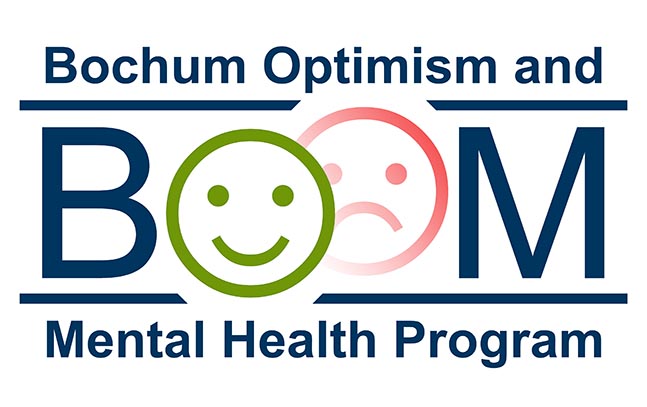
Bochum
Optimism and
Mental Health
A program of the Mental Health Research and Treatment Center
Investigated constructs*
-
Sociodemographic data (e.g., age, gender, height, weight, migration background)
Outcomes:
Positive Mental Health
-
Positive Mental Health (PMH-Scale; Lukat et al., 2016),
-
Self-Esteem (SISE; Robins, Hendin, & Trzesniewski, 2001)
Negative Mental Health
-
Depression, Anxiety and Stress (DASS-21; Henry & Crawford, 2005),
-
Facebook Addiction (BFAS; Andreassen et al., 2012),
-
Suicidal tendencies (SBQ-R; Osman et at., 2001),
-
Rumination,
-
Trauma,
-
Gaming Addiction,
-
Experience with treatment of mental disorders
Predictors:
stable (traits)
-
Optimism (LOT-R; Schreier, Carver, & Bridges, 1994),
-
Sense of Coherence (SOC-L9; Schumacher et al., 2000),
-
Resilience (RS-11; Schumacher et al., 2005),
-
Values (PVQ-21; Schwartz et al., 2001),
-
Delay of Gratification (DDT; Forstmeier & Maercker 2010),
-
Risk-Taking (Singe-Item Questionnaire; Dohmen et al., 2009),
-
„Big Five“ (BFI-10; Rammstedt & John, 2007),
-
Narcissism (NPI-13; Gentile et al., 2013),
-
Controllability,
-
Attractiveness
dynamic (states)
-
Subjective Happiness (SHS; Lyubomirsky & Lepper, 1999),
-
Satisfaction with Life (SWLS; Diener et al., 1985),
-
Social Support (F-SozU K-14; Fydrich et al., 2009),
-
Self-Efficacy (GSES; Schwarzer & Jerusalem, 1995),
-
Self-Evaluation (BIDR; Musch, Brockhaus, & Bröder, 2002),
-
Partnership (PFB; Hahlweg, 1996),
-
Daily Hassles (BDDS; Scholten et al., in prep.),
-
Physical Health (EQ-5D; Brooks, 1996)
-
Bullying (BRC; Wolke & Sapouna, 2008),
-
Family Affluence Scale (FAS; Boyce et a., 2006),
-
Rhythm of Life (BSRS; Margraf et al., 2016),
-
Life Style (LS; Velten et al., 2014),
-
Media Use,
-
Desire to have children
* Not all constructs were used in all surveys.
